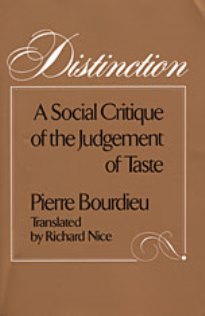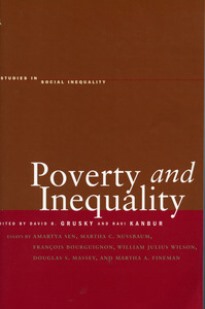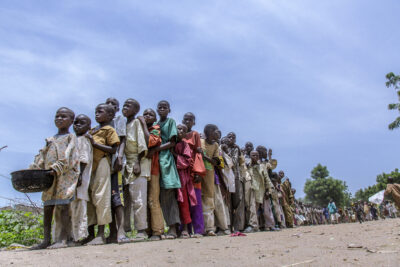As scholarly interest in inequality flourishes, so too have calls for new approaches, for better measures, or for more attention to a particular aspect of the problem. Each such call makes the case for the importance of a new insight, perspective or measure; however, the burden has been to demonstrate a meaningful improvement in our understanding of inequality or ability to address it. In this essay, I argue for integrating theoretical insights from relational approaches into empirical scholarship on inequalities, providing an example from my own work on the production of civic inequalities in schools to highlight the value-added of using this approach.
A distributional perspective dominates our understanding of inequality, resulting in an increasingly rich but largely descriptive account of wage, income, and wealth gaps. A relational lens on inequality promises to both sharpen our focus and broaden our field of vision, improving our understanding of causes, explanations, and outcomes that are often missed or overlooked by purely distributional accounts.
“While there are many distinctions that can be made in regard to the study of inequality…one of the least utilized and understood is distributional vs. relational.”
While there are many distinctions that can be made in regard to the study of inequality (opportunity vs. outcome; between group disparities vs. overall dispersion, etc.), one of the least utilized and understood is distributional vs. relational. At the most general level, this division corresponds to what Pierre Bourdieu1 Cambridge, MA: Harvard University Press, 1984More Info → and Mustafa Emirbayer2Mustafa Emirbayer, “Manifesto for a Relational Sociology,” American Journal of Sociology 103, no. 2 (1997): 281-317. describe as the difference between “substantialist analysis” and “relational analysis.” While the former begins by specifying objects of analysis as “things” and then asks how they are patterned in relation to one another, the latter begins by specifying the terms of relations and then asks how they operate to constitute social things and actors, position them in relation to one another, and regulate transactions among them.
Cambridge, MA: Harvard University Press, 1984More Info → and Mustafa Emirbayer2Mustafa Emirbayer, “Manifesto for a Relational Sociology,” American Journal of Sociology 103, no. 2 (1997): 281-317. describe as the difference between “substantialist analysis” and “relational analysis.” While the former begins by specifying objects of analysis as “things” and then asks how they are patterned in relation to one another, the latter begins by specifying the terms of relations and then asks how they operate to constitute social things and actors, position them in relation to one another, and regulate transactions among them.
In other words, distributional accounts shed light on inequalities by analyzing how resources, opportunities, and outcomes are divided among actors. Relational accounts shed light on inequalities by analyzing the positions actors occupy in relation to one another and the terms that structure their interactions. “One can think of inequality as it exists within a society in terms of the distributions of attributes of its individual members that are in some sense ranked,” as John Goldthorpe explains, “individuals differ–i.e., are unequal–in their incomes, wealth, standards of consumption, the desirability of their occupations, their educational attainments, the extent of their social and cultural participation, etc.”3John H. Goldthorpe, “Analyzing Social Inequality: A Critique of Two Recent Contributions from Economics and Epidemiology,” European Sociological Review 26, no.6 (2010): 731-744. Such a formulation, Goldthorpe argues, is descriptively valuable but theoretically limited:
However, inequality can also be thought of, at a deeper level, in terms of social relations in the context of which individuals are in some sense advantaged or disadvantaged. Social stratification then refers to inequality that is of a structured kind or, that is, to inequality insofar as it is not merely a matter of individual fortune but rather inherent in prevailing forms of social relationship that have in some degree an institutional basis. The positions that individuals hold within forms of social stratification will be major determinants of their life-chances and life-styles, and will also condition many of their important life-choices. In turn, social stratification can then be seen as crucial to the understanding of the different kinds of inequality that are observable at an attributional level.4John H. Goldthorpe, “Analyzing Social Inequality: A Critique of Two Recent Contributions from Economics and Epidemiology,” European Sociological Review 26, no.6 (2010): 731-744.
Broadening our lens in the study of inequality to include relational accounts is critically important. For starters, it expands our field of vision. Relational accounts are necessary complements to distributional accounts and they have important implications for both descriptive and explanatory work. In descriptive work, the focus is on the object of study–a resource or a relation. For example, while distributive accounts characterize inequalities by describing the distribution of some good or resource among a group of people (e.g., unequal resources), relational accounts characterize inequalities by describing the relations between them (e.g., unequal relations).
“We must have an expansive understanding of inequality in order to avoid the risk of missing or misunderstanding important ways in which inequalities are maintained, exacerbated, or ameliorated.”In explanatory work, the distinction is on the primary mechanism or process. In terms of explanation, distributional accounts explain inequalities as resulting from initial or prior distributions of resources, which are then converted through some allocation process to the unequal outcome or opportunity, whereas relational accounts explain inequalities as resulting from the terms of relations that both constitute and connect individuals. This most fundamental of tasks cannot be taken for granted. As inequality scholars Prudence Carter and Sean Reardon explain, one of the biggest challenges to the study of inequality is “the creation of conceptual and empirical models that more holistically capture the cumulative and systemic factors that have created and continue to sustain inequality.”5Prudence L. Carter and Sean F. Reardon. “Inequality Matters,” William T. Grant Foundation Inequality Paper (2014): 24.
More info → We must have an expansive understanding of inequality in order to avoid the risk of missing or misunderstanding important ways in which inequalities are maintained, exacerbated, or ameliorated.
Understanding the wide range of thinking about inequality is also essential to imagining strategies to address it. If one begins with a relatively narrow view of what inequality is and how it comes about, then the range of solutions for addressing it will be just as narrow and limited. While a distributional lens would point to solutions that focus on how the initial resources are distributed, solutions in a relational account would focus on the structure and qualities of relations. David Grusky and Ravi Kanbur similarly argue for the importance of theoretical and conceptual pluralism in regard to the study of inequality and poverty, noting that “pressing problems of policy cannot be adequately addressed without first making conceptual advances.”6 Palo Alto, CA: Stanford University Press, 2006More Info → If the goal is to reduce social and economic inequalities, we must first understand the multifaceted complexity and depth of the problem at hand from different conceptual positions.
Palo Alto, CA: Stanford University Press, 2006More Info → If the goal is to reduce social and economic inequalities, we must first understand the multifaceted complexity and depth of the problem at hand from different conceptual positions.
While both approaches are acknowledged by inequality scholars, the distributional way of thinking about and examining inequality is dominant largely because of the relative ease with which we can match individual-level distributional explanations to the individual-level data is used to investigate inequalities. However, more relational understandings of the constitutive power of relations and the importance of position and relative position can also be obtained from this type of data.
Applying a relational lens
In my work, I use a relational perspective to examine how schools create unequal citizens. The approach I take differs from most work on how education matters for political inequality, which focuses on the civic goods schools distribute, such as cognitive abilities, practical skills, or knowledge of the political system. I shift attention from such distributive dynamics to the ways schools function as sites for direct experiences of civic relations. It is at the schoolhouse that most individuals have their first, formative experiences of public membership, institutional rules, forms of authority, and peer groups of putative equals. Thus, rather than asking how schools allocate “things,” such as skills and knowledge, I pursue a theoretical and empirical account of how schools work to organize political relations, position students differently within these relations and, as a result, provide students with experiences that set them on paths toward different modes of citizenship.
“We show how statistical analyses of survey data (a method based on distributions) can be used to illuminate and test theoretical claims regarding relational inequalities in school organizations.”In a recent paper7 Sarah Bruch and Joe Soss. “Learning where we stand: How school experiences matter for civic marginalization and political inequality.” (working paper, Washington Center for Equitable Growth, 2016).
More info →, my colleague Joe Soss and I use this relational understanding of inequality and connect it with the recent turn toward meso-level analysis in citizenship studies. In doing so, we develop a novel account of how schools construct citizens and position them in the polity. Building on this theoretical intervention, our paper presents an empirical analysis of how students’ school experiences matter for later societal incorporation, attitudes toward government, and patterns of civic and political engagement. Rather than study how dynamic school relations unfold in a direct manner (for example, through ethnographic observation in school settings) we pursue an empirical strategy James Coleman formulated8 James Coleman,“Relational Analysis: The Study of Social Organization with Survey Methods,”
Human Organization 17, no.4 (1958): 28-36. and urged scholars to adopt as early as 1958. Taking up Coleman’s challenge, we show how statistical analyses of survey data (a method based on distributions) can be used to illuminate and test theoretical claims regarding relational inequalities in school organizations. Drawing on Add Health9 The National Longitudinal Survey of Adolescent Health (Add Health) is a nationally representative longitudinal study of adolescents who were in grades 7 through 12 during the 1994-95 school year. Add Health used a multi-stage, stratified, school-based, cluster sampling design to select 80 high schools and their feeder schools from a sampling frame of all schools in the U.S. that had at least 30 students and included an 11th grade (N=26,666 students in 132 schools).
More info →, a nationally representative panel dataset, we observe six types of student experiences with school-based relations: encounters with schools as organized cultural contexts; encounters with the rules and environmental features that structure schools as political contexts; personal experiences of being targeted by disciplinary uses of official authority; subjective perceptions of whether, in general, school officials use their authority fairly; objective levels of integration into organized, peer-participation school activities; and subjective perceptions of inclusion vs. marginalization in the school community.
We first examine how racial relations intersect with relations of gender and class to position students in schools and define their experiences of school relations. We then turn to a more complex analysis of the direct and indirect paths that connect formative school experiences to later patterns of civic and political engagement among young adults. Putting the two halves of our analysis together, we find strong evidence that students who occupy more subordinate positions in social relations are more likely to have formative school experiences that channel them toward subordinate and marginalized positions in civic and political life. For example, we find that black students are substantially more likely to have negative experiences in their vertical relations with school authorities. They have a 57 percent greater chance of being singled out for punishments, such as suspensions and expulsions, than their white counterparts. They are also 28 percent more likely than white students to perceive teachers as unfair in their treatment of students in general. In analyses examining these experiences’ impact, we find both reduce the likelihood that young adults will participate civically and result in lower levels of trust in government.
“Our analysis clarifies that this process works through an extended chain of translation in which positions and experiences in one relational field structure positions and experiences in subsequent fields.”Schools function as key mechanisms for more than just the reproduction of social inequalities: they are equally central to the process that converts social subordination into civic and political marginalization. Moreover, our analysis clarifies that this process works through an extended chain of translation in which positions and experiences in one relational field structure positions and experiences in subsequent fields. Adolescents who occupy subordinate positions in social relations of race, class, and gender are channeled toward inferior positions and experiences in school-based relations. Their disproportionately negative experiences of school relations shape their subsequent “policy careers” in ways that diminish their entry into valued civic positions (e.g., college attainment) and position them as subjects of the state’s most paternalist and authoritarian apparatuses (e.g., criminal justice and means-tested welfare). These developments, in turn, play a mediating role, translating negative experiences of school relations into an inferior form of civic incorporation marked by lower levels of electoral participation, civic engagement, and trust in government.
This example provided from my work with Joe Soss demonstrates the value of integrating theoretical insights from the relational perspective to the empirical study of inequality. Others have adopted the relational perspective in the study of inequality with fruitful results as well. For example, Donald Tomaskovic-Devey and Dustin Avent-Holt have developed a relational theory of workplace inequalities and earnings inequality that they use to compare the social relations across organizations, enabling them to describe and explain the variability in earnings inequality across organizations.10 Donald Tomaskovic-Devey, Martin Hallsten, and Dustin Avent-Holt, “Where Do Immigrants Fare Worse? Modeling Workplace Wage Gap Variation with Longitudinal Employer-Employee Data,” American Journal of Sociology 120, no.4 (2015): 1095-1143. Demonstrating the empirical utility of a relational approach is not confined to those using quantitative data and analytical methods. Matthew Desmond has articulated a relational approach to ethnography, which he used in his recent study of urban poverty and eviction in Milwaukee, Wisconsin, to show how the process of eviction and relational ties among residents contribute in various ways to increasing economic and housing instability.11Matthew Desmond, “Relational Ethnography,” Theory and Society 43 (2014): 547-579. These are just a handful of recent examples of the value of a relational approach in the study of inequality. Incorporating a broad range of ways of thinking about inequality will enhance not only our understanding of inequality but, most importantly, our efforts to reduce it.
References:
More info →
More info →
Human Organization 17, no.4 (1958): 28-36.
More info →













